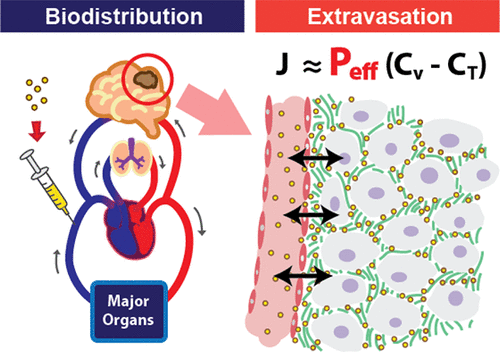当前位置:
X-MOL 学术
›
ACS Biomater. Sci. Eng.
›
论文详情
Our official English website, www.x-mol.net, welcomes your
feedback! (Note: you will need to create a separate account there.)
Estimating Tumor Vascular Permeability of Nanoparticles Using an Accessible Diffusive Flux Model
ACS Biomaterials Science & Engineering ( IF 5.4 ) Pub Date : 2020-03-23 , DOI: 10.1021/acsbiomaterials.9b01590 Marc Lim 1, 2 , Vishnu Dharmaraj 3 , Boying Gong 4 , Benson T. Jung 5 , Ting Xu 5, 6
ACS Biomaterials Science & Engineering ( IF 5.4 ) Pub Date : 2020-03-23 , DOI: 10.1021/acsbiomaterials.9b01590 Marc Lim 1, 2 , Vishnu Dharmaraj 3 , Boying Gong 4 , Benson T. Jung 5 , Ting Xu 5, 6
Affiliation

|
Understanding the complex interplay of factors affecting nanoparticle accumulation in solid tumors is a challenge that must be surmounted to develop effective cancer nanomedicine. Among other unique microenvironment properties, tumor vascular permeability is an important feature of leaky tumor vessels which enables nanoparticles to extravasate. However, permeability has thus far been measured by intravital microscopy on optical window tumors, which has many limitations of its own. Additionally, mathematical models of particle tumor transport are often too complicated to be accessible to most researchers. Here, we present a more simplified and accessible mathematical model based on diffusive flux, which uses particle tumor accumulation and plasma pharmacokinetics to yield effective permeability, Peff. This model, called diffusive flux modeling (DFM), allows effects from multiple parameters to be decoupled and is also the first demonstration, to the best our knowledge, of extracting Peff values from bulk biodistribution results (e.g., routine positron emission tomography studies). The DFM equation was used to explain in vivo results of sub-20 nm nanocarriers called three-helix-micelles (3HM), particularly 3HM’s selective accumulation in different tumor models. When DFM was applied to multiple published biodistribution data, a semiquantitative comparison of various tumor models, particle size, and active targeting strategies could be made. The analysis clearly pointed out the importance of balancing multiple characteristics of nanoparticles to ensure successful treatment outcome and highlights the usefulness of this simple model for initial particle design, selection, and subsequent optimization.
中文翻译:

使用可访问的扩散通量模型估算纳米粒子的肿瘤血管通透性
了解影响实体瘤中纳米颗粒积聚的因素之间复杂的相互作用是开发有效的癌症纳米药物必须克服的挑战。在其他独特的微环境特性中,肿瘤血管的通透性是渗漏的肿瘤血管的重要特征,其可使纳米颗粒渗出。然而,迄今为止,通过活体显微镜对光学窗肿瘤测量了渗透性,这本身具有许多局限性。另外,粒子肿瘤转运的数学模型通常过于复杂,大多数研究人员无法使用。在这里,我们提出了一种基于扩散通量的更简化和可访问的数学模型,该模型使用颗粒肿瘤累积和血浆药代动力学来产生有效的渗透率P eff。该模型称为扩散通量建模(DFM),它允许将多个参数的影响解耦,并且,就我们所知,这也是首次从大量生物分布结果中提取P eff值的演示(例如,常规的正电子发射断层扫描研究) 。DFM方程用于解释体内20纳米以下纳米载体的结果,称为三螺旋胶束(3HM),特别是3HM在不同肿瘤模型中的选择性积累。当DFM应用于多个已发表的生物分布数据时,可以对各种肿瘤模型,粒径和主动靶向策略进行半定量比较。该分析明确指出了平衡纳米颗粒多种特征以确保成功治疗结果的重要性,并强调了此简单模型对初始颗粒设计,选择和后续优化的有用性。
更新日期:2020-03-23
中文翻译:

使用可访问的扩散通量模型估算纳米粒子的肿瘤血管通透性
了解影响实体瘤中纳米颗粒积聚的因素之间复杂的相互作用是开发有效的癌症纳米药物必须克服的挑战。在其他独特的微环境特性中,肿瘤血管的通透性是渗漏的肿瘤血管的重要特征,其可使纳米颗粒渗出。然而,迄今为止,通过活体显微镜对光学窗肿瘤测量了渗透性,这本身具有许多局限性。另外,粒子肿瘤转运的数学模型通常过于复杂,大多数研究人员无法使用。在这里,我们提出了一种基于扩散通量的更简化和可访问的数学模型,该模型使用颗粒肿瘤累积和血浆药代动力学来产生有效的渗透率P eff。该模型称为扩散通量建模(DFM),它允许将多个参数的影响解耦,并且,就我们所知,这也是首次从大量生物分布结果中提取P eff值的演示(例如,常规的正电子发射断层扫描研究) 。DFM方程用于解释体内20纳米以下纳米载体的结果,称为三螺旋胶束(3HM),特别是3HM在不同肿瘤模型中的选择性积累。当DFM应用于多个已发表的生物分布数据时,可以对各种肿瘤模型,粒径和主动靶向策略进行半定量比较。该分析明确指出了平衡纳米颗粒多种特征以确保成功治疗结果的重要性,并强调了此简单模型对初始颗粒设计,选择和后续优化的有用性。











































 京公网安备 11010802027423号
京公网安备 11010802027423号